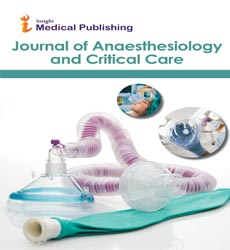In a Resource Constrained Environment, Spinal Anaesthesia for a Pre Eclamptic Patient with HELLP Syndrome.
Timsel Girma*
Department of Anesthesiology, Dilla University, Canada, USA
- *Corresponding Author:
- Timsel Girma
Department of Anesthesiology, Dilla University, Canada, USA
E-mail: timselgirma@gmail.com
Received Date: September 03, 2021; Accepted Date: September 22, 2021; Published Date: September 29, 2021
Citation: Girma T (2021) In a Resource Constrained Environment, Spinal Anaesthesia for a Pre Eclamptic Patient with HELLP Syndrome. J Anaesthesiol Crit Car. Vol.4 No.1:05
Perspective
Thrombocytopenia is a well-known clinical manifestation, with studies showing that roughly 1% of pregnant women had a platelet count of less than 100 109/L. The cut-off value for neuraxial anaesthetic administration in thrombocytopenic mothers is still unknown. The purpose of this case report is to describe the anaesthetic care of a case requiring emergency hysterotomy. When used for a parturient with HELLP syndrome, fine-needle spinal anaesthetic has a lower risk of subarachnoid hematoma, especially when continued postoperative follow-up is provided, as we did in our case.
Introduction
Thrombocytopenia is described as a platelet count of fewer than 150 109/L, which affects about 10% of patients undergoing surgery. It has a well-known clinical appearance, with studies showing that roughly 1% of pregnant women had a platelet count of less than 100 109/L. Preeclampsia, gestational thrombocytopenia, and immune thrombocytopenic purpura are the most common causes of thrombocytopenia. The advantages of spinal anaesthetic over general anaesthetic include adequate sensory and motor block, effective postoperative analgesia, and the avoidance of airway obstruction and aspiration risk. The use of spinal anaesthetic in a patient with thrombocytopenia, on the other hand, is controversial. The cut-off value for neuraxial anaesthetic administration in thrombocytopenic mothers is still unknown. Neither the American Society of Anaesthesiologists nor the Society for Obstetric Anesthetic and Perinatology has issued an official recommendation on a cut-off value for spinal anaesthesia delivery at this time. The basic theory to explain the typical laboratory results of HELLP syndrome is endothelial injury of the hepatic vasculature, which is followed by platelet activation, aggregation, and consumption, resulting in hepatocyte ischemia and death. These results are found in about 6–8% of pregnancies and, when combined with eclampsia, are responsible for considerable morbidity and mortality in obstetric patients.
Blood pressure values greater than or equal to 160/110 mmHg at rest, severe proteinuria and oliguria (400 mL 24 h-1), changes in vision, headache, and other brain changes, epigastric pain, signs of pulmonary edoema, cyanosis, and HELLP syndrome are all signs of severe preeclampsia, which leads to organ damage. Ideal patient care can be determined based on the advantages and disadvantages of each anaesthetic plan as well as the pathophysiological manifestation of the disease. When choosing an anaesthetic strategy, the various anaesthetic options and their potential adverse effects should be thoroughly reviewed and communicated to patients. After spinal anaesthesia, patients' neurological condition must be continuously checked.
The most up-to-date information on the anaesthetic care of a mother with HELLP syndrome who planned a caesarean section is unclear. In light of the potential for problems, it appears that a general anaesthetic plan containing medicines that provide patient stability is a prudent choice.
In a survey conducted in Turkey, patients and anaesthesiologists preferred general anaesthesia to obstetricians–gynecologists in patients with low platelet counts. Most responders preferred general anaesthesia for platelet levels of 50,000/L or eclampsia (94.4 percent for very low platelets and 89.5 percent for eclampsia). A case of subarachnoid hematoma was described in a patient who had a caesarean delivery for severe preeclampsia with HELLP syndrome under spinal anaesthesia. She experienced numbness on the back of her right leg, was oblivious to bladder fullness, and had mild flaccid paraparesis when she was examined. Because there is no clear standard for choosing anaesthesia for HELLP syndrome, practitioners must be aware of the signs and symptoms of a subarachnoid hematoma and be prepared to intervene.
Patients may experience acute onset of severe back and radicular pain at the site of the haemorrhage. As a result of the paresis or paralysis, motor and sensory impairments appear. A third of individuals with a spinal subarachnoid haemorrhage experience cerebral symptoms or indicators of meningeal irritation, including headache, vomiting, nuchal rigidity, and acute back pain.
According to a research 119 patients with HELLP syndrome, 85 of whom required caesarean delivery, none of the patients who underwent the procedure under regional anaesthetic experienced neurological or haematological problems, which matched our case report. In contrast, a report of a spinal subarachnoid hematoma following spinal anaesthesia in a parturient with HELLP syndrome was explained by another researcher. According to the findings, fine-needle spinal anaesthetic for a parturient with HEELP syndrome may lower the risk of subarachnoid hematoma if continuing postoperative follow-up is provided. The findings in our case report imply that interventional clinical studies should be conducted in a well-equipped setting in the future. Furthermore, it may provide highlights for clinicians who are deciding on anaesthetic plans based on information about their patients. Though these experiences may be useful in the administration of anaesthesia in resource-constrained poor nations, we propose conducting further clinical trials in a well-equipped setting.
The optimum anaesthetic plan for a parturient with HELLP syndrome that is planning a caesarean section is not obvious based on the most recent pieces of information. Despite the risks, the SA technique with a fine needle (25G G Quincke needle) for a parturient with HELLP syndrome appears to have a lower risk of subarachnoid hematoma. More research is needed to rule out the possibility of epidural hematoma in a patient with HELLP syndrome who receives SA, especially in a well-equipped setting.
Open Access Journals
- Aquaculture & Veterinary Science
- Chemistry & Chemical Sciences
- Clinical Sciences
- Engineering
- General Science
- Genetics & Molecular Biology
- Health Care & Nursing
- Immunology & Microbiology
- Materials Science
- Mathematics & Physics
- Medical Sciences
- Neurology & Psychiatry
- Oncology & Cancer Science
- Pharmaceutical Sciences
